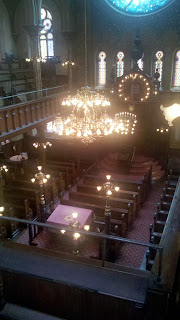Other than the movie, I had never really heard about pulp fiction, so it was interesting to learn that the first comics that moved from news papers to their own "books" or comic books were the first pulp fiction. From the 1920s through the 1940s, pulp fiction was in its hey day. Magazine stands were covered with these cheap forms of entertainment (remember there were no to few TVs and during part of this time the Depression made leisure activities something to be treasured) made from wood pulp.
Artists that painted cover art for these magazines and book conversions (like the Tarzan serial that became an adventure book--see right), were considered the lowest of the commercial artists. They were looked down upon in the art community and they mostly were embarrassed by or ashamed that they were doing these pieces to pay the rent and buy food. A cover art piece would earn the artist between $50-$100, which was huge money at that time (as a point of reference, a subway token was 5 cents as compared with today's $2.25), but none of the pulp fiction artists were highly regarded and many of them did not sign their work.
Because, like the magazines, pulp fiction art was considered disposable, most of the art was lost. Nobody wanted to save and store the artwork. Sometimes artists would paint right over prior work for the next job. Tragically, I learned that when Conde Nast bought a comic book publishing company in NYC, they cleaned out the storage space by leaving hundreds of paintings on Madison Avenue to be picked up by trash collectors!
The artwork on display at the Society of Illustrators is wonderful. They are vivid (there was a science and method to the pulp art after they discovered that bright colors like red on shirts and dresses and yellow backgrounds best caught consumers' attentions--and their nickels). They are dramatic. They capture the imagination (mostly of young adolescent boys--ergo the voluptuous damsels in distress--see left). They illustrate a time in this country's history where escapism was needed and pulp fiction and pulp art filled this need.
 If you are in the neighborhood, take the time to visit and you won't be disappointed. Their current exhibit includes wonderful pulp art and movie artifacts (see Robby the Robot model at right) that you can visit for free! And amazingly, on Tuesday and Thursday evenings, they have sketch sessions with live models that you can attend for a nominal $15 fee. This little brownstone on the upper east side is a hidden gem that shouldn't be missed.
If you are in the neighborhood, take the time to visit and you won't be disappointed. Their current exhibit includes wonderful pulp art and movie artifacts (see Robby the Robot model at right) that you can visit for free! And amazingly, on Tuesday and Thursday evenings, they have sketch sessions with live models that you can attend for a nominal $15 fee. This little brownstone on the upper east side is a hidden gem that shouldn't be missed.


















































